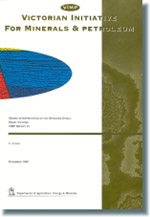VIMP Report 21 - Seismic Interpretation of the Offshore Otway Basin, Victoria
 |
| |||||
Product description:Download The downloadable version of this report is supplied in PDF format. Executive Summary A regional seismic interpretation of the offshore Otway Basin in Victoria has been carried out. The study area extends from Cape Otway in the east to the Victoria/South Australia border in the west and covers Area V95-O1 and Permits VIC/P35, VIC/P30 & VIC/P31. The seismic interpretation was carried out using a Charisma seismic workstation. A total of 5000 line km of high quality seismic data acquired in 1991 as well as 1980-1982 data reprocessed in 1993, were selected for interpretation. The data forms an approximate 5 km x 7 km grid over the entire study area. Information from all the available offshore wells have been incorporated into the study. Four major structural elements have been recognized: namely the Voluta Trough, the Normanby Terrace, the Mussel Platform and the Shipwreck Trough. The major gas discoveries at Minerva and at La Bella 1 lie within the Shipwreck Trough. Four major sequence boundaries, the Base of the Heytesbury Group, the Top of the Wangerrip Group, the Top of the Sherbrook Group and the Top of the Eumeralla Formation have been mapped over the entire area. The Eumeralla Formation contains the major source rock within the study area and it is mature for oil and gas generation. The Top of the Eumeralla Formation is extensively faulted facilitating the migration of the hydrocarbons into the reservoirs above. Good reservoir quality sands are present within the Wangerrip Group and the Sherbrook Group. Sands of the Waarre Formation at the base of the Sherbrook Group form the major exploration target within the study area. The interpretation has revealed that none of the four exploration wells drilled within the vacant Area V95-O1 has tested a valid structural closure at the main objective level. The seismic events at this level were masked by multiples and noise in the old seismic data. A significant number of untested fault controlled closures have been mapped at the Top of the Eumeralla Formation which directly underlies the Waarre Formation. Many of these closures lie in water depth of less than 150 m. A large untested fault closure lies in water depth of less than 50 m in the vacant Area V95-O1. None of the wells drilled within the Voluta Trough have investigated a complete Waarre Formation sequence. Seismic data indicate the presence of a very thick Eumeralla Formation within the Voluta Trough, which may contain additional sedimentary sections to that penetrated in the onshore wells. All the structural closures mapped at the Top of the Eumeralla Formation in the western part of the study area were fully developed by the end of the Cretaceous. The sands of the Waarre Formation were able to trap any hydrocarbons generated before the deposition of the thick Tertiary carbonate sequence. In the eastern part, the Minerva structure did not fully develop until the mid Tertiary time whereas the Pecten structure developed during the mid to late Tertiary time. Potential may also exist for turbidite and low stand fan deposit plays within the shallow Tertiary sequence. Bibliographic reference Sarma, S., 1995. Seismic interpretation of the offshore Otway Basin, Victoria. Victorian Initiative for Minerals and Petroleum Report 21. Department of Agriculture, Energy and Minerals. | ||||||

